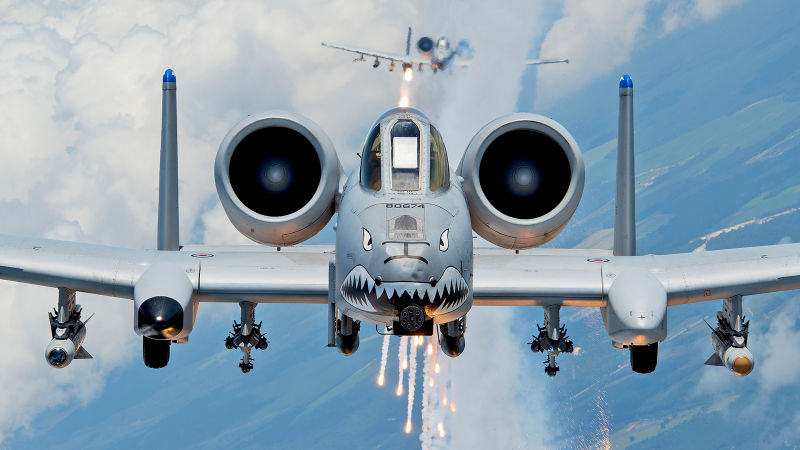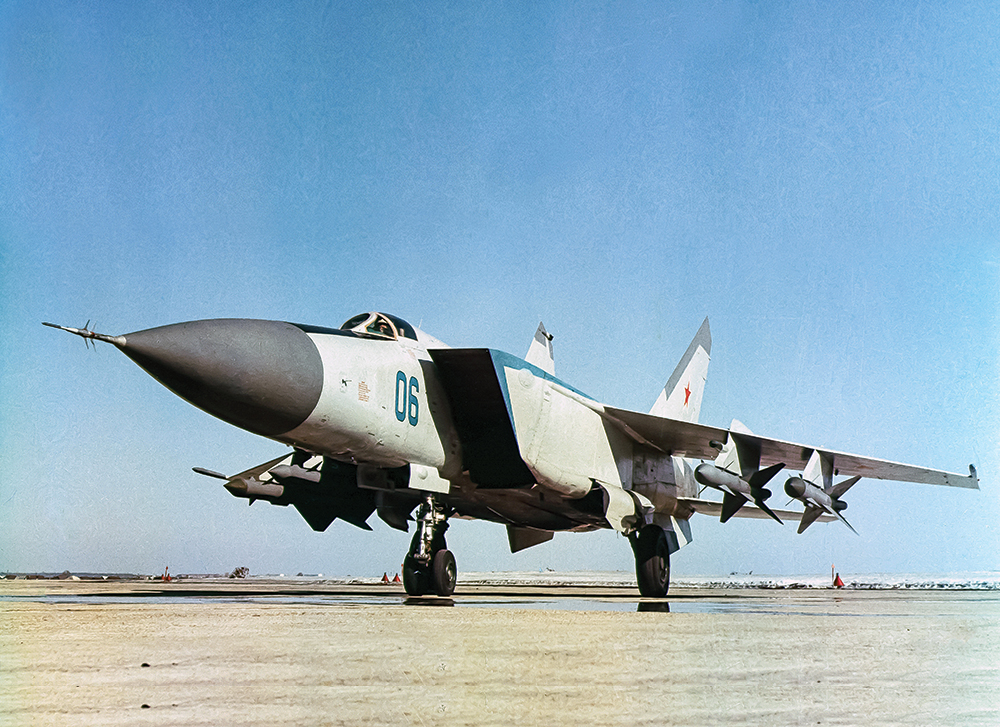The title is for 70s AND 80s.
No, the Title is:
Active Military Fighter Aircraft of the 70'ies
And for a good reason, since in the early to late 70'ies the Warsaw Pact still had NATO on it's balls, on every aspect regarding land and air. (I am not knowledgeable in naval issues).
That is why the "new" generation developed and placed into active service, starting in the 70'ies, was to extremely important, and totally outclassed/outmatched the Warsaw Pact from the 80'ies onward.
But go against weapons that can shoot back like T-72s,
A T-72 doesn't really shot back at aircraft - aside from those mounted with the 12,7mm Dushka. - and they aren't operated during battle. The latter was already in service on T-10's, T-55's or T-62's - as such no improvement or surprise via a T-72. The same goes for the Warsaw pact's 37 and 57mm AA guns being around and known since WW2. And the A-10 was specifically armored/hardened in view of the Dushka and in regards to the widespread ZU-23 AA gun.
You have to understand that the Iraq Military was rated as 5th in the world.
Only in numbers and US/NATO propaganda - factually they were a nobody. I had been there just shortly before Desert-Storm, they couldn't even place AA guns in such a manner, so that they wouldn't obliterate each other. Even their Republican Guards were a joke in regards to training and tactical proficiency.
Around half of their fighter aircraft only existed on paper and taxing on the ground. No pilots, no training not even weaponry - I was very well aware of that due to contacts to Dassault and the French Air-force in regards to Iraq's F-1's in the No. 79 Squadron. Those units operating the F-1 had even flown a far lower number of combat sorties against Iran than those operating MiG-21s or Su-22s. Out of around 100 F-1's, less then 25 could be flown and only around 15 crews were factually proficient in flying that type.
If you remember during Desert Storm - more then half of the "operational" IrAF were send for "safekeeping" to Iran.
You have no idea what "Going Downtown" means.
I was referring to the South - since an A-10 would hardly fly all the way and into the North. The A-10 was specifically designed and placed into service for CAS - and as such always operated in conjunction with air-cover provided by the fixed wings and additionally actually foremost, covered/assisted by the ground forces - and there were no US ground forces in the North. As such using a A-10 in the North would defy CAS, and would be pure suicidal.
What helped the A-10 was the placement of engines, high and to the rear partial covered by the wings. That means, it was harder to take out from below.
Exactly
How many Mig Kills has the A-10 done in combat? How about zero.
Since it never faced combat against other countries air-forces or was in any danger in that respect - that question doesn't even make sense. The A-10 wasn't meant to engage enemy fixed wing aircraft - neither was the A-1E.
The A-10 however was also intended to engage the Warsaw Pact's massive helicopter fleet.
What you totally ignore about the A-10 was the intention of the loitering capability of that aircraft during CAS missions - and due to it's phenomenal turn radius - it was able to not totally overshot a target before or after engaging it - but to continuously "turn it's rounds" over recognized ground targets. I had witnessed numerous times during maneuvers as to how these A-10's kept harassing and continuously engaging ground targets - no one on the ground was able to shake off these buggers - unlike an e.g. F-104G or Fiat G-91, that would swoop in, drop it's weapon load all over the place and vanish as in "not to return".
A1-EH and the A-7DE regularly operated above the DMZ supporting downed pilots for pickup. While we were sending in everything that flew into that area to support the rescue choppers (Jolly Greens usually)
That is known - and the A-10 was never used nor intended for such a mission by NATO in the 70'ies nor 80'ies. It did however perform such missions in Iraq, due to the given US air supremacy and virtually non existing Iraqi AA effectiveness.
I was involved in the Weisbotten (sp) War games. Nato against Warsaw. I was on the Warsaw side. What came out of it was NATO had to cheat to hold Warsaw off. They made the tanks only operate on well defined roads and were kept single file. That isn't the way they operated. When the firing starts, the Armor scatters and begins to fight. Like the Japanese from their Midway wargames, NATO cheated and would have been met with a disaster in real life. So to win, NATO had to cheat on the ground.
I am aware - as I had stated on before; in the 70'ies the Warsaw Pact would have overrun NATO or at least Germany and Denmark. That is why the NATO forward strategy of the 50'ies was entirely revised in the 70'ies and came into full effect in the 80'ies due to these "new" generation Fighter Aircraft and the factual availability of the F-4 incl. Wild Weasel and the Panavia Tornado in NATO, incl. the CAS concept involving the A-10 - and not some A-7 or A-6 - that couldn't loiter and harass.
The A-10, as a coin or CAS is rapidly being replaced by the USAF AT-6 and Navy AT-29. They don't need the huge canon or the excess speed or the ability to take direct hits and keep on ticking. What they need is agility, range, keep it a small package and for the least amount of operating costs.
Correct - basically taken care of by Drones and long range missile artillery (HIMARS/MARS/PzH2000 etc.) - I don't really see a purpose or advantage in using an AT-6 or AT-29 for such tasks. especially not in regards to reaction time and vulnerability to AA. It's an antiquated concept IMO.
Provide e.g. Ukraine with sufficient HIMARS etc. and modern Drones (Predator) and the war would already be over, and there would be no need for those old-timer F-16's and nonsensical Leopard 1's and II A4's.
In Ukraine, the A-7 would be preferable to the A-10. I bring that up because the A-7 and the SU-25 have about the same amount of everything going for it. Speed is life and the A-10 doesn't really have the speed nor the power to extend after the target. You fire the A-10s gun and the Aircraft drastically slows down. It only has a .35 power to weight ratio while the SU-25 has about a .5. What a low powered attack bird has to do after it hits it's target is to keep low, build up speed and then pop up. It's called extending. This leaves the A-10 much more vulnerable than the SU-25.
Again an A-10 is about CAS in conjunction with air-superiority and ground support. The A-7 would face the same horrid losses as the SU-25, used and lost on both sides. Because no side has air-superiority over Ukraine and the respective ground troops are not capable of offensive drives - thus not able to set up an own AA support and can't get at the respective opponents AA units - aside from e.g. HIMARS.
You mean 3 years after. The A10 was put into service in 1978 while the SU-25 went into service in 1981. Before that, the SU-7 was the primary ground attack fighter. The SU-7 was introduced in 1955 and served honorably until the newer SU-25 replaced it almost 30 years later. The flight characteristics of the SU-7 was slightly less than the A-7E.
The SU-25 wasn't around in any significant numbers before end of the 80'ies. The first of the Warsaw Pact countries to receive the Su-25K was the Czechoslovakian Air Force, receiving it's first 5 units somewhere in 1984.
I remember that very well - since during an aircraft recognition training of a Roland and Gephard unit around 1985 - someone had asked as to what the SU-25 looks like. (it hadn't been depicted on the recognition chart) By then the A-10 was roaming in full strength over Germany and the production of the A-10 had IIRC already come to an end in 1984.
With the introduction of the "new" generation fighter aircraft and the deployment of foremost Roland and also the Gephard units alongside the Patriot system - the Warsaw Pact air-force had ceased to being a threat to NATO from the mid 80'ies onward.
But the F-16 was already on the planning boards and that killed the A-7 upgrade.
Exactly - and the immediate CAS mission was given to the A-10's.




